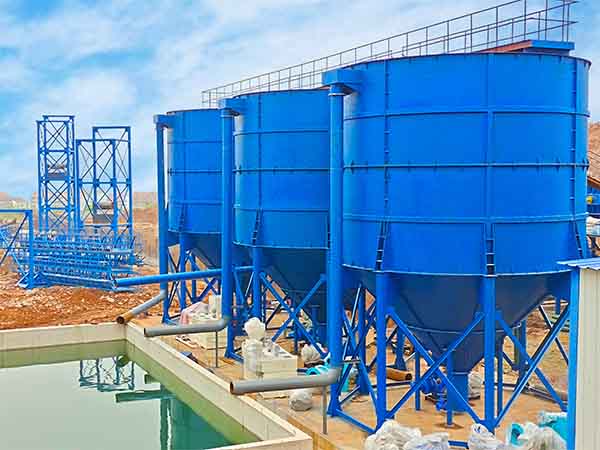Wastewater Treatment Process Proposal Sand Washing Plant
The wastewater treatment process proposal sand washing plant is mainly to reduce the suspended solids in the wastewater. The purified wastewater is recycled, and the waste residue is dewatered and transported out for disposal. The deep cone thickener can increase the concentration of 20% pulp to about 70%, and the dehydration effect is very good.
After adding flocculant, the wastewater discharged from the sand washing plant in the pre-sedimentation tank enters the thickener for mud-water separation and sedimentation. After treatment, the separated clean water is returned to the clean pool for recycling. The mud in the sedimentation tank is transported by a mud pump to the filter press for dewatering treatment, and the mud cake is transported together with the mud from the drying field to the nearby backfill area of the sand mining field for landfill. The sludge accumulated in the pre-sedimentation tank is cleared by manual and regular slag removal. The cleared sludge is transported to the sludge drying field for drying, and is regularly cleared out and transported to the mining backfill area for landfill.
The sand washing wastewater enters the advection grit chamber for pretreatment, the longest sedimentation time is 4 hours, and the large particles of sediment in the wastewater are removed. The sludge at the bottom of the pool is regularly dredged by a submersible mud pump, and the effluent from the sedimentation tank enters the clean water tank, and is reused or discharged up to the standard through the circulating water pump.
Treatment agent selection
1. Flocculant: plays the role of electric neutralization and adsorption. Destabilize the particles in the wastewater or agglomerate the suspended matter. Polyferric sulfate, polyferric chloride, or basic aluminum chloride can be used. The reference dosage is about 20mg/L.
2. PH adjuster: in the process of flocculation, the pH value of flocculation mainly affects the state of charge of pollutants in wastewater and the degree of hydrolysis of chemical components, thereby affecting the number of chemicals used and the effect of water effluent.
3. Coagulant: polyacrylamide anionic polymer flocculant used in water purification treatment. The reference dosage is about 6-12mg/L, and the dosage should be adjusted according to the actual effluent water quality to ensure that the effluent water quality is clear.
Related Products
There are no relevant articles.



